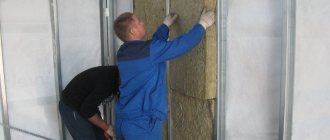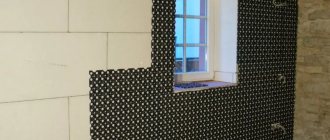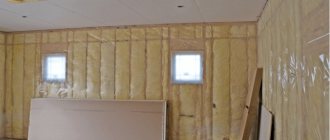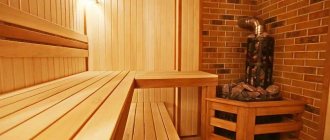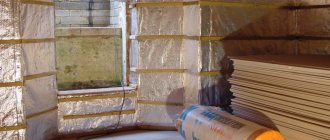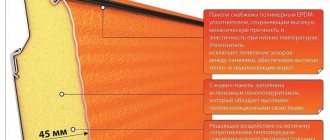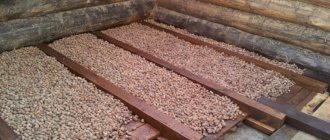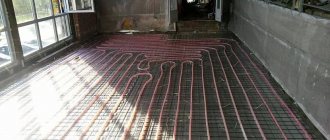If you have experienced the purchase or sale of apartments, then you have noticed that buyers do not really like corner apartments or rooms. What is this connected with? Although it is much easier to ventilate such an apartment in summer, the view from the windows opens on two or even three sides.
But there is one significant drawback. Very often, with the arrival of frost, residents of corner apartments suffer from insufficient heat. If the temperature outside is around zero, and the heating season has not yet begun, uncomfortable conditions are created inside such an apartment. Dampness appears in the corners, the windows fog up, the floor becomes cold, and the bed becomes damp.
The main reason for this is the presence of three walls that have access to the outside and are therefore most susceptible to low temperatures. In winter, even with central heating, the situation only gets worse.
The walls can freeze completely, especially in the corners, the interior decoration will begin to fall off, and mold and mildew will appear. Staying in such an apartment will not only be uncomfortable, but also unsafe, especially for children. After all, they are most susceptible to diseases caused by high air humidity.
What to do in such a situation? Many people try to install additional heating radiators, but this, most often, does not solve the problem or solves it, but not completely. Dampness moves to the ceiling, forming places where mold accumulates.
What is the right thing to do in such a situation? The best solution is to try to insulate the walls. How can I do that? How to carry out internal insulation? We'll try to figure it out now. What is the best way to insulate the walls of an apartment from the inside? First, let's look at what insulation materials exist.
Why insulate corner apartments?
Despite the rapid growth in the number of modern residential complexes, many Russians still live in outdated Khrushchev buildings. These buildings feature old heating systems and cannot withstand sudden weather changes. First of all, residents of corner apartments suffer from this. With the first cold snap, their homes become cold, because cool air very quickly penetrates the cracks in the walls of buildings. Another important reason for the need to install insulation lies in the layout of corner apartments. In them, not one, but two walls border the street, which further aggravates the situation of the residents. In such situations, even the presence of batteries and additional heaters cannot save the inhabitants.
The corner of the apartment is freezing
Due to severe frosts, the corners of adjacent walls of the room freeze over. As a result, plaster and wallpaper come away from the surface, which causes mold and mildew to appear. The corner rooms become very damp and an unpleasant odor develops, which interferes with normal living. Unable to withstand such conditions, sooner or later people ask the question: “How to insulate a corner bedroom or living room?” With this necessary procedure, you can not only make your stay more comfortable, but also save on heating costs. Plus, residents of the house will be protected from dangerous fungi that cause asthma and other respiratory diseases.
A little theory: dew point
There is a concept called “dew point”. This is the temperature at which condensation forms - the moisture in the air becomes water droplets.
This point can be outside, inside or inside the wall. When humidity levels increase and temperature decreases, the microclimate in the corner room provokes the formation of condensation. Due to the violation of the location of the point, mold and mildew form on the walls.
Walls need to be insulated from the outside. This makes them warmer from the inside, moving the point to the outer edges, and prevents the development of fungi and mold. If it is not possible to make thermal insulation from the outside, it is permissible to insulate the end wall from the inside, just choose materials so that the point remains inside the supporting structure.
Insulation makes the room warm and prevents dampness. The microclimate becomes comfortable, and you don’t have to worry about your health. It is important to carry out the installation correctly to obtain effective results.
Choosing a material - mineral wool or polystyrene foam?
Today, in order to insulate a corner room, there are a lot of different materials. They are classified into those that are used for installation outside and those that are intended for installation inside the house. It is worth remembering that there is no universal material, because each of the insulation materials has its own advantages and disadvantages. Among the main requirements for materials are:
- high thermal conductivity;
- airtightness;
- ability to absorb moisture;
- appropriate environmental friendliness;
- flammability resistance;
- long service life.
Using lathing
To have an idea of the properties of the most popular materials, it is worth considering each of them in more detail. Mineral wool has long been considered the most popular insulation material. The main raw material for the production of this insulation is basalt. The material is one of the products with a low degree of flammability. Even if the product starts to burn, it does not emit acrid smoke that can somehow harm a person.
Installing mineral wool does not require any skills. This material is very pliable and plastic; it presses tightly against the wall and does not lag behind it for a long time. However, after a certain time, the cotton wool absorbs moisture and begins to deform. In addition, research has revealed that the material contains a small proportion of substances that are harmful to the human respiratory tract. Among other disadvantages, it is worth highlighting the large mass of the product, which makes it difficult to install alone.
Another popular material is polystyrene foam or, as it is also called, expanded polystyrene. This is polystyrene well beaten with a powerful mixer, cooled to low temperatures. The prices for this product are very low, and installation does not require skills or much physical effort. The lion's share of the material's composition is ordinary air, so it is absolutely harmless to the health of residents. This insulation is one of the few that can be used both outside and inside a building. The reason is resistance to temperature changes from -170 to +60 °C.
The insulation can be mounted on various surfaces. There is no need to use special fasteners. Another advantage of the material is its long service life. In addition to its advantages, insulation also has its disadvantages. Thus, the material cannot be used for installation in a wooden building, as it produces a large amount of condensate inside it. However, the product works great in a brick building or in buildings built from concrete blocks.
Features of insulation in brick houses
At the beginning of work, you need to protect the surface and apply a primer with antifungal components. When insulating with mineral wool, a frame is built from slats, and pieces of material are placed between them on glue. Glue is applied to the wall, the seams are covered, and rubbed. Then gypsum board, primer, paint, and wallpaper are laid.
When working with polystyrene foam, the glue is applied with a spatula. There should be no gaps left; they are reliably coated with sealant. The finishing is carried out with a fiberglass plaster mesh - it helps to smooth out the adhesive layer, and the gypsum board is fixed to it.
In a brick house
When applying plaster, 3 layers will be required, each layer must be completely dry. Then a primer is applied, a leveling layer. The wall is painted or wallpapered. To insulate the corner, you can use thermal paint. Before applying it, prepare the base, then apply the paint with a roller or brush. After drying, you can glue the wallpaper.
External insulation
For external cladding, mineral wool, polyurethane foam or expanded polystyrene are used.
The mineral wool is placed on glue, additionally secured with anchors, the resulting seams are rubbed down and smoothed with sealants. Reinforcement is placed on top, then facade paint is applied.
Expanded polystyrene is placed on a profile frame. The walls underneath the material are treated with a special solution. The slabs are placed on glue. The corners are rubbed down, a layer of plaster and paint are applied on top.
When using polyurethane foam, a metal mesh is first installed. The material is applied by spray. It is covered with adhesive, reinforcement, plaster, and façade paint.
Installation of insulation inside a panel building - where to start?
Features of installing the material may vary slightly depending on the type of building. The first option we will consider is panel construction. To insulate the walls in the rooms of a corner apartment, first of all, you need to clean the surfaces. Therefore, it is best to install the material immediately before performing cosmetic or major repairs. As soon as the surfaces are cleaned, proceed with the installation of waterproofing in the form of special polymer membranes. In the vast majority of cases, their role is played by polyethylene films with a thickness of no more than 0.3 mm.
Insulation of the apartment from the inside
When stretching waterproofing, it is very important to install the material as accurately as possible, without leaving any section of the wall open. To do this, select a membrane strictly in accordance with the area of the apartment. If whole pieces of material are not available for sale, it can be purchased in the form of wide strips. The next step will be the installation of wooden or metal sheathing. An important nuance - if the structure is made of wood, it will need to be treated with an antiseptic before installation. The distance between the partitions of the sheathing should not be less than the width of one unit of insulation.
So, if you bought polyurethane foam slabs with a width of 2 m, then the distance between the partitions of the structure should also be 2 m. This way you can install insulation without leaving gaps
Installation of insulation
After installing the sheathing, it is time to install the insulation material. Most products are produced in the form of mats, one side of which is springy. When you squeeze the material, it shrinks and then immediately returns to its original shape. This makes installation of insulation much easier. After installation, the surfaces of the material are covered with vapor barrier protection. It will ensure insulation of walls and insulation from condensation. At this stage you also need to try to act as accurately as possible, without leaving cracks or grooves. For greater reliability, it is worth applying a sealant at the joints of the vapor barrier.
Work order
When planning insulation, you must first do dismantling, removing everything that will interfere with the work. During the work, satellite antennas and galvanized canopies over the windows should be removed. Installation in solid sheets is much more reliable. When cutting material in the event of obstacles, cold bridges are formed. Despite the minimum heat loss, such bridges provoke the accumulation of dampness between the insulation and the wall.
The wall is cleaned with a coarse brush with metal bristles or a grinding machine - this way the unevenness is eliminated.
Carrying out work
More attention needs to be paid to interpanel seams. In old houses, all connections are coated with sealant for maximum insulation effect.
The panels are fastened from top to bottom, laid horizontally. Panels made of polystyrene foam and polyurethane are glued and additionally fixed with dowels - 5 pieces for each element.
The main structures are also insulated. The material is cut according to their shape.
After installing the insulator, the joints are sealed with mounting foam and masking tape. The panels are plastered and treated with special compounds.
Installing material in a brick building - tips for amateurs
The process of installing insulation inside a brick building has its own characteristics and is slightly different from insulating rooms in a panel building. However, there should not be any special difficulties during the work process. Since polystyrene foam is considered the most popular material for this type of work, we will consider the operating algorithm using the example of this particular insulation.
Insulation with polystyrene foam
First of all, you need to properly prepare the surface of the brick wall. If there is no plaster on it, then it must be applied. If you are starting to install insulation in an already residential area, then dismantle the wall finishing and putty before installation. If necessary, level the surface of the walls, seal all gaps and cracks and apply a primer that will penetrate into the smallest and deepest pores. It is important that the primer contains substances with antiseptic properties.
In the next step, dilute the glue. This is done strictly in accordance with the instructions for use of the composition. We apply the mixture to the surface of the walls with a smooth spatula, after which we work the layer with a tool with teeth. Without waiting for the glue to dry, take sheets of polystyrene foam and apply them one by one to the wall, pressing tightly and holding for several seconds. There is no point in using dowels to fix the insulation, since the glue will hold the material perfectly on the wall.
We install slabs without gaps
When installing each slab, make sure that there are no gaps between them! Remember that the denser the material is installed, the warmer it will be in your apartment. Further actions depend only on your plans. If you are planning to apply putty over the insulation, you will need to prime the surface before doing this. If plaster will be applied, it is necessary to install a reinforcing mesh.
Features of insulation in a panel house
It is often necessary to insulate corner rooms in a panel house, because there are 2 external walls. If it is not possible to insulate from the outside, you will have to carry out work from the inside, although the first option is more effective and correct.
In a panel house
To make the apartment warmer, a foam or mineral wool thickness of 50-80 mm is required. The best choice in this situation is stone wool. It allows moisture to pass through, does not burn, does not smoke, does not absorb moisture vapor, and does not require additional waterproofing or vapor barrier. The price of mineral wool is much more expensive.
You can carry out budget insulation of walls as follows:
- attach 50 mm thick foam plastic to the wall, seal the joints;
- install a metal profile structure;
- fix the wall plasterboard.
Reflective insulation is not needed - it is expensive, completely ineffective, and suitable for baths where there is a lot of infrared radiation. It should be placed behind the battery.
Foam brands are the most popular insulation
In stores you can find not one, but several brands of polystyrene foam. Depending on the production method of the material, the inscriptions “PS” and “PSB” can be found on the packaging. The first means that the material was made using the press method, and the second – without pressing. In addition to this marking, there are also numbers on the foam packaging. What do they mean?
Thus, S-15 is a very dense material produced using the non-press method. This foam is excellent for exterior work in multi-story buildings; it is often used to insulate attics and roofs. Among its properties, it is worth highlighting environmental friendliness, high moisture resistance and fire resistance. S-25 PSB is another insulation material manufactured using a non-press method. This type of foam is perfect for installation in corner apartments, as it has all the qualities necessary for this. In addition, this type of polystyrene foam is often used to insulate floors and loggias.
Polystyrene foam brand S-35 PSB
If there are a large number of communications in the walls, or their installation is just planned, then for better insulation it is worth choosing foam plastic of the S-35 PSB brand. A big advantage of the material is its resistance to bad weather conditions. It is absolutely not afraid of mechanical damage and has high fire resistance. Expanded polystyrene grade S-50 PSB is considered the densest. It is often used in regions where hail often falls and strong winds blow. Such insulation is not afraid of precipitation, condensation or mechanical damage. True, its cost is quite high.
Penofol
Penofol is a combination of polyethylene foam and aluminum foil. This is a whole series of materials (including single-sided, double-sided, laminated, with an adhesive layer). Moreover, it can be used both in combination with other heat-insulating materials, and independently.
By the way, penofol is popular for insulating a bathhouse from the inside, and there is much more steam there than in an ordinary living room.
Penofol - alternative insulation
Mineral foam – how to decide?
This material is also in high demand due to its characteristics and reliability. However, not all of its brands are suitable for certain jobs. Thus, cotton wool marked P-75 will be an excellent insulation material in corner apartments. She is not afraid of moisture and fire. However, if this material is not laid correctly, it will deform very quickly due to its ability to absorb condensate vapor. Mineral wool P-125 is denser and stronger than the first type. It is often installed outside buildings made of brick and concrete in regions with mild climates. However, it is completely unsuitable for use in buildings located in the northernmost regions of Russia. Another disadvantage of this material is its high cost.
Cotton wool of the PPZh-200 and PZh-175 brands is characterized by increased density and rigidity. She is not afraid of temperature fluctuations or the influence of frequent precipitation. The only drawback is the large mass of the slabs. To insulate a home, 3–4 people are required. As for the manufacturers of the material, the products of the companies Isover, Ursa, Rockwool and Isorok are considered to be of the highest quality.
Creating a double wall
Another method of insulation is to create a double wall with heated floor elements. This method involves mounting heating elements on the wall. In order to install such a structure, it is necessary to create a second wall. This can be done using drywall or building a full-fledged thin wall from half-bricks. The presence of a false wall allows you to install insulation on its inside.
However, this method has a number of disadvantages:
- Firstly, it greatly reduces the living space.
- Secondly, the double wall does not provide the most powerful heating.
- Thirdly, this method requires a lot of electricity consumption.
Nuances when processing a balcony
The specifics of insulating a balcony look almost identical to the thermal insulation of the walls inside the building. At the same time, on the loggia you also need to protect the ceiling and floor.
If polystyrene foam is chosen as an insulator, it can be attached to the walls using foam adhesive. The next layer is to install a wooden sheathing. It can be secured with dowels.
The optimal insulation thickness is between 50 and 80 mm.
In addition, you can insulate the balcony before painting. To do this, putty, reinforced mesh and another layer of putty must be applied to the foam plastic. After the surface has dried, it must be coated with a primer and painted. In this case, foam plastic with a density of 25 kg / cubic meter is used. m.
Preparatory activities
Work on thermal insulation of an apartment begins with the preparation of materials and tools. In addition to the insulator, for insulation you will need:
- Vapor barrier film. It is used to protect the wall from moisture. In its absence, the surfaces will quickly become saturated with condensation and become covered with mold.
- Material for installing the frame. These can be boards or wooden beams. A profile is also suitable for installation.
- Drywall or other finishing material (plastic panels, lining, siding, etc.).
Before purchasing the listed products, you need to calculate the square footage of the walls. This will allow you to select the optimal amount of materials and plan the budget for the upcoming insulation.
Before starting work on thermal insulation, it is necessary to calculate the square footage of the walls.
Next you need to prepare the walls. It consists of cleaning the surface from old wallpaper, tiles and other coverings. If there is gypsum putty or plaster on the wall, it is best to remove it with a hammer, hammer drill or chisel. Next, the wall needs to be treated with an antiseptic, which will prevent the formation of mold.
When it is not possible to insulate the outside
Ideally, place a layer of insulation on the outside of the building along its facade. But owners do not always manage to implement this option. There may be several reasons for this:
- the facade of the house is prohibited from changing due to its historical value (the situation is typical for old brick apartment buildings); insulation work must be carried out at a high altitude, and the owners do not have the opportunity to turn to professional builders; the distance between neighboring houses is too small to allow work with external walls.
In all of the above cases, you will have to resort to internal insulation. The main task in such a situation is to avoid the harmful effects of condensation on the insulation.
There are two common ways to solve this:
- When using mineral (basalt) wool, the vapor barrier film is overlapped, and all seams are carefully taped. When using materials with very low permeability, you can dispense with the vapor barrier film, since the insulation does not get wet. As such a material, you can choose polystyrene foam or penofol with a foil layer.
The best materials and methods of thermal insulation
When choosing which technologies to give preference to when insulating walls, builders take into account the installation conditions, the characteristics of the selected material, as well as the required degree of protection. The most appropriate combinations of modern thermal insulation materials and decorative finishing products, which additionally perform the function of insulation, are recognized.
Installation of polystyrene foam or polystyrene foam
When extruded polystyrene foam (EPS) appeared on the building materials market, ordinary non-pressed polystyrene foam (PSB) became less used, since it was inferior in a number of characteristics to the new material. Among its negative qualities is that insulation:
- Releases toxic substances when burned or melted.
- It is fragile and therefore cannot withstand mechanical pressure.
- Doesn't scare rodents.

